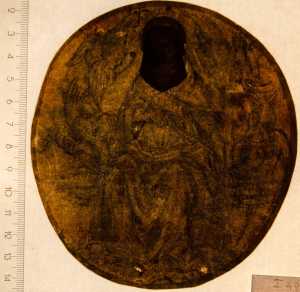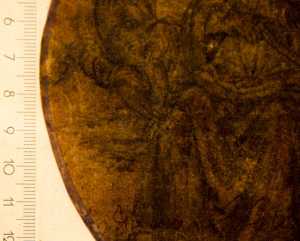Specifications
| Title | Seated Virgin Mary with a Girdle Surrounded by Four Cherubim |
|---|---|
| Material and technique | Pen and brush and black ink, grey wash, heightened with white, indented for transfer, the reverse prepared with charcoal |
| Object type |
Drawing
> Two-dimensional object
> Art object
|
| Location | This object is in storage |
| Dimensions |
Height 130 mm Width 120 mm |
|---|---|
| Artists |
Draughtsman:
Raffaellino del Garbo
|
| Accession number | I 498 (PK) |
| Credits | Loan Stichting Museum Boijmans Van Beuningen (former Koenigs collection), 1940 |
| Department | Drawings & Prints |
| Acquisition date | 1940 |
| Creation date | in circa 1515-1525 |
| Watermark | fragment of a unidentifiable watermark (130 x 120 mm, on the right edge, centre, vV, 4P) [see image] |
| Inscriptions | '[...]' (verso, top left, pen and brown ink), '80/83/82 [?]' (verso, top right, pen and brown ink), 'die sono L[...] / [...]acta [?]' (verso, bottom centre, pen and brown ink) |
| Collector | Collector / Franz Koenigs |
| Mark | T. Lawrence (L.2445), A. Grahl (L.1199), F.W. Koenigs (L.1023a deest) |
| Provenance | Sir Thomas Lawrence (1769-1830, L.2445 deest), London: Art dealer Samuel Woodburn (1781-1853, L.2584), acquired with the Lawrence Collection in 1834; his sale, London (Christie) 04-08.06.1860, in lot 409 (Raffaellino del Garbo, BP 0/13/0); August Grahl (1791-1868, L.1199), Dresden; his sale, London (Sotheby) 27-28.04.1885, lot 116, ill. (Raffaelino del Garbo, BP 5/6/0); - : Franz W. Koenigs (1881-1941, L.1023a), Haarlem, acquired in 1920-1930 (Florence, 15th century); D.G. van Beuningen (1877-1955), Rotterdam, acquired with the Koenigs Collection in 1940 and donated to Stichting Museum Boijmans Van Beuningen |
| Research |
Show research Italian Drawings 1400-1600 |
| Literature | Grahl 1885, no. 116, ill. |
| Material | |
| Object | |
| Technique |
Perforate
> Punctured
> Subtractive techniques
> General technique
> Technique
> Material and technique
Perforate
> Punctured
> Subtractive techniques
> General technique
> Technique
> Material and technique
Prepare
> Prepared
> Shaping techniques
> General technique
> Technique
> Material and technique
Prepare
> Prepared
> Shaping techniques
> General technique
> Technique
> Material and technique
Highlight
> Painting technique
> Technique
> Material and technique
Brown wash
> Washing
> Wash
> Drawing technique
> Technique
> Material and technique
|
| Geographical origin | Italy > Southern Europe > Europe |
| Place of manufacture | Florence > Tuscany > Italy > Southern Europe > Europe |
Do you have corrections or additional information about this work? Please, send us a message

























